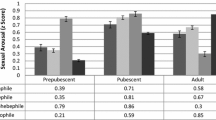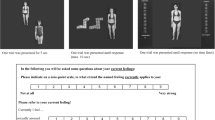Abstract
In forensic research, there is a controversial discussion concerning the changeability or stability of pedophilia. Seto (2012) conceptualized pedophilia as a sexual age orientation characterized by an early onset, correlations with sexual and romantic behavior, and stability over time. However, empirical data are sparse and are mostly based on samples of detected offenders. The present study examined self-reported arousal to sexual fantasies involving children in a clinical sample of pedo-/hebephiles. In Study 1, retrospective self-reports on the age of onset and duration of sexual interest in minors were examined. In Study 2, the stability and variability of self-reported arousal to sexual fantasies involving children were evaluated prospectively. Non-prosecuted self-identifying pedo-/hebephilic men seeking professional help were recruited within the Berlin Prevention Project Dunkelfeld. Between 2005 and 2013, 494 participants completed the intake assessment. Self-reported data were collected via questionnaire focusing on sexual arousal to fantasies during masturbation involving prepubescent and/or early pubescent minors. Subsequent assessments of sexual arousal were obtained for 121 of the participants. The average time between the first and last assessment was approximately 29 months. Spearman’s correlation coefficients examined the between-group rank-order and Wilcoxon signed-rank tests examined the within-individual mean-level stability. The majority of subjects reported an early onset of their pedo-/hebephilic sexual arousal. The rank-order stability was medium to high. Over the investigated period, the majority of subjects showed no or only minimal decrease or increase of self-reported sexual arousal. These results suggested that sexual arousal to fantasies involving prepubescent and/or early pubescent children is stable. Furthermore, the results support the conceptualization of pedo-/hebephilia as a sexual age orientation in men.

Similar content being viewed by others
Notes
The two items for sexual arousal to adult females and males were only included in the QSEB around October 2007. Therefore, reported sample sizes for these items are smaller.
References
Ahlers, C. J., Schaefer, G. A., & Beier, K. M. (2004). Erhebungsinstrumente in der klinischen Sexualforschung und der sexualmedizinischen Praxis—Ein Überblick über die Fragebogenentwicklung in Sexualwissenschaft und Sexualmedizin [Assessment instruments in clinical sexology and sexological research—An overview of questionnaires in sexology and sexual medicine]. Sexuologie, 11(3/4), 74–97.
American Psychiatric Association. (2013). Diagnostic and statistical manual of mental disorders (5th ed.). Washington, DC: Author.
Asendorpf, J. B. (1992). Beyond stability: Predicting inter-individual differences in intra-individual change. European Journal of Personality, 6(2), 103–117.
Babchishin, K. M., Nunes, K. L., & Kessous, N. (2014). A multimodal examination of sexual interest in children: A comparison of sex offenders and non-sex offenders. Sexual Abuse, 26(4), 343–374.
Bailey, J. M. (2014). A failure to demonstrate changes in sexual interest in pedophilic men: Comment on Müller et al. (2014). Archives of Sexual Behavior, 44, 249–252.
Bailey, J. M., Hsu, K. J., & Bernhard, P. (2013). Survey of pedohebephilic men. Unpublished raw data.
Beckstead, A. L. (2012). Can we change sexual orientation? Archives of Sexual Behavior, 41, 121–134.
Beier, K. M. (1998). Differential typology and prognosis for dissexual behaviour—A follow-up study of previously expert-appraised child molesters. International Journal of Legal Medicine, 111, 133–141.
Beier, K. M., Ahlers, C. J., Goecker, D., Neutze, J., Mundt, I. A., Hupp, E., & Schaefer, G. A. (2009). Can pedophiles be reached for primary prevention of child sexual abuse? First results of the Berlin Prevention Project Dunkelfeld (PPD). Journal of Forensic Psychiatry & Psychology, 20(6), 851–867.
Beier, K. M., Amelung, T., Kuhle, L., Grundmann, D., Scherner, G., & Neutze, J. (2015a). Hebephilia as a sexual disorder. Fortschritte der Neurologie-Psychiatrie, 81(3), 128–137.
Beier, K. M., Bosinski, H. A., & Loewit, K. (2005). Sexualmedizin. München: Elsevier Urban & Fischer.
Beier, K. M., Grundmann, D., Kuhle, L. F., Scherner, G., Konrad, A., & Amelung, T. (2015b). The German Dunkelfeld Project: A pilot study to prevent child sexual abuse and the use of child abusive images. Journal of Sexual Medicine, 12, 529–542.
Berlin Institute of Sexology and Sexual Medicine. (2013). The Berlin Dissexuality Therapy Program. Weimar: Gutenberg Druckerei GmbH.
Blanchard, R., Kuban, M. E., Blak, T., Klassen, P. E., Dickey, R., & Cantor, J. M. (2012). Sexual attraction to others: A comparison of two models of alloerotic responding in men. Archives of Sexual Behavior, 41(1), 13–29.
Blanchard, R., Lykins, A. D., Wherrett, D., Kuban, M. E., Cantor, J. M., Blak, T., … Klassen, P. E. (2009). Pedophilia, hebephilia, and the DSM-V. Archives of Sexual Behavior, 38(3), 335–350.
Cantor, J. M. (2015). Purported changes in pedophilia as statistical artefacts: Comment on Müller et al. (2014). Archives of Sexual Behavior, 44(1), 253–254.
Cohen, L. J., & Galynker, I. I. (2002). Clinical features of pedophilia and implications for treatment. Journal of Psychiatric Practice, 8(5), 276–289.
Dombert, B., Schmidt, A. F., Banse, R., Briken, P., Hoyer, J., Neutze, J., & Osterheider, M. (2015). How common is males’ self-reported sexual interest in prepubescent children? Journal of Sex Research. doi:10.1080/00224499.2015.1020108.
Durbin, C. E., & Klein, D. N. (2006). Ten-year stability of personality disorders among outpatients with mood disorders. Journal of Abnormal Psychology, 115(1), 75.
Field, A. (2013). Discovering statistics using IBM SPSS statistics. London: Sage.
Foote, W. E., & Laws, D. R. (1981). A daily alternation procedure for orgasmic reconditioning with a pedophile. Journal of Behavior Therapy and Experimental Psychiatry, 12(3), 267–273.
Freund, K., & Kuban, M. (1993). Toward a testable developmental model of pedophilia: The development of erotic age preference. Child Abuse and Neglect, 17(2), 315–324.
Hampson, S. E., & Goldberg, L. R. (2006). A first large cohort study of personality trait stability over the 40 years between elementary school and midlife. Journal of Personality and Social Psychology, 91(4), 763.
Hanson, R. K., Steffy, R. A., & Gauthier, R. (1993). Long-term recidivism of child molesters. Journal of Consulting and Clinical Psychology, 61(4), 646–652.
Lalumière, M. L. (2015). The lability of pedophilic interests as measured by phallometry. Archives of Sexual Behavior, 44(1), 255–258.
Laws, D. R., & Marshall, W. L. (1990). A conditioning theory of the etiology and maintenance of deviant sexual preference and behavior. Handbook of sexual assault (pp. 209–229). New York: Springer.
Lussier, P. (2015). Juvenile sex offending through a developmental life course criminology perspective: An agenda for policy and research. Sexual Abuse: A Journal of Research and Treatment. doi:10.1177/1079063215580966.
Mann, R. E., Hanson, R. K., & Thornton, D. (2010). Assessing risk for sexual recidivism: Some proposals on the nature of psychologically meaningful risk factors. Sexual Abuse: A Journal of Research and Treatment, 22(2), 191–217.
Marshall, W. L. (1997). The relationship between self-esteem and deviant sexual arousal in nonfamilial child molesters. Behavior Modification, 21(1), 86–96.
Marshall, W. L. (2008). Are pedophiles treatable? Evidence from North American studies. Seksuologia Polska, 6(1), 39–43.
Marshall, W. L., O’Brien, M. D., & Marshall, L. E. (2009). Modifying sexual preferences. In A. Beech, L. Craig, & K. Browne (Eds.), Assessment and treatment of sex offenders: A handbook (pp. 311–328). Chichester: John Wiley & Sons Ltd.
Marshall, W. A., & Tanner, J. M. (1969). Variations in pattern of pubertal changes in girls. Archives of Disease in Childhood, 44(235), 291–303.
Marshall, W. A., & Tanner, J. M. (1970). Variations in the pattern of pubertal changes in boys. Archives of Disease in Childhood, 45(239), 13–23.
Mokros, A., & Habermeyer, E. (2015). Regression to the mean mimicking changes in sexual arousal to child stimuli in pedophiles. Archives of Sexual Behavior. doi:10.1007/s10508-015-0652-8.
Müller, K., Curry, S., Ranger, R., Briken, P., Bradford, J., & Fedoroff, J. P. (2014). Changes in sexual arousal as measured by penile plethysmography in men with pedophilic sexual interest. Journal of Sexual Medicine, 11(5), 1221–1229.
Mummendey, H. D., & Grau, I. (2008). Die Fragebogen-Methode [The Questionnaire-Method]. Gottingen: Hogrefe Verlag.
Neutze, J., Seto, M. C., Schaefer, G. A., Mundt, I. A., & Beier, K. M. (2011). Predictors of child pornography offenses and child sexual abuse in a community sample of pedophiles and hebephiles. Sexual Abuse: A Journal of Research and Treatment, 23, 212–242. doi:10.1177/1079063210382043.
Ponseti, J., Granert, O., Jansen, O., Wolff, S., Beier, K., Neutze, J., … Bosinski, H. (2012). Assessment of pedophilia using hemodynamic brain response to sexual stimuli. Archives of General Psychiatry, 69(2), 187–194.
Roberts, B. W., & DelVecchio, W. F. (2000). The rank-order consistency of personality traits from childhood to old age: A quantitative review of longitudinal studies. Psychological Bulletin, 126(1), 3.
Schaefer, G. A., Mundt, I. A., Feelgood, S., Hupp, E., Neutze, J., Ahlers, C. J., … Beier, K. M. (2010). Potential and Dunkelfeld offenders: Two neglected target groups for prevention of child sexual abuse. International Journal of Law and Psychiatry, 33(3), 154–163.
Schmidt, A. F. (2013). Indirekte Messverfahren pädophiler sexueller Interessen: Ein Überblick über empirische Ergebnisse und methodische Implikationen [Indirect measurement methods of pedophilic sexual interests—An overview of empirical results and methodic implications]. In P. Briken, J. L. Müller, M. Rösler, M. Rettenberger, V. Klein, & D. Yoon (Eds.), EFPPP Jahrbuch 2013. Empirische Forschung in der forensischen Psychiatrie, Psychologie und Psychotherapie (pp. 65–75). Berlin, Germany: Medizinisch Wissenschaftlich Verlagsgesellschaft.
Seto, M. C. (2008). Pedophilia and sexual offending against children: Theory, assessment, and intervention. Washington, DC: American Psychological Association.
Seto, M. C. (2012). Is pedophilia a sexual orientation? Archives of Sexual Behavior, 41(1), 231–236.
Tozdan, S., & Briken, P. (2015). The earlier, the worse? Age of onset of sexual interest in children. Journal of Sexual Medicine, 12(7), 1602–1608.
Acknowledgments
The authors would like to thank Corinne Kaszner for the language revision and the helpful comments on early versions of this article and Robert Röhle for the statistical advice.
Author information
Authors and Affiliations
Corresponding author
Rights and permissions
About this article
Cite this article
Grundmann, D., Krupp, J., Scherner, G. et al. Stability of Self-Reported Arousal to Sexual Fantasies Involving Children in a Clinical Sample of Pedophiles and Hebephiles. Arch Sex Behav 45, 1153–1162 (2016). https://doi.org/10.1007/s10508-016-0729-z
Received:
Revised:
Accepted:
Published:
Issue Date:
DOI: https://doi.org/10.1007/s10508-016-0729-z




